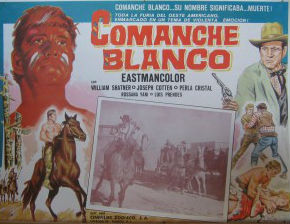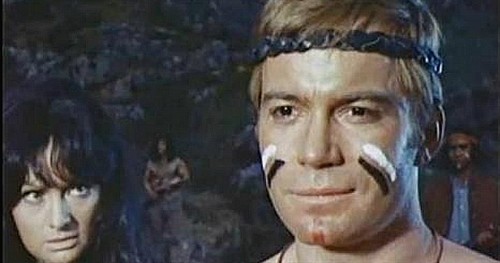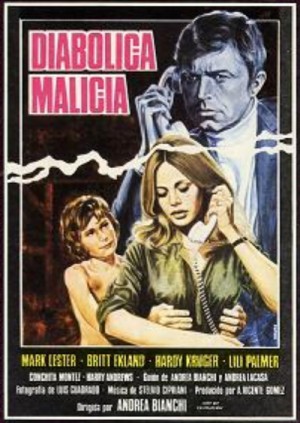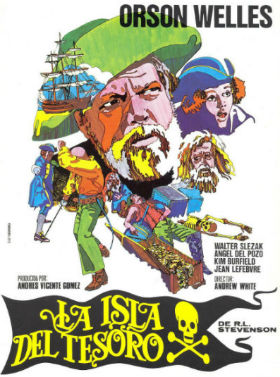During the 1960s, many foreign movies were filmed in
Spain. Samuel Bronston made Spain fashionable and countless
technicians, actors, second unit directors and others in the
industry who weren't successful in the USA achieved a higher
quality of life in Madrid than they could have ever afforded in
their own country. Chamartín, and particularly the so-called
neighborhood of "Corea" (Korea), in the upper part of Dr. Fleming
Street, was full of such personalities. Bruce Yorke, an Australian
I met in London, introduced me to Gilbert Kay, a second unit
director in some of the movies filmed here. Kay was looking for a
producer and handed me a script called "Comanche blanco" (White
Comanche). Westerns had become popular again thanks to the
financial stimulus Spain had given to the genre. I would like to
take this opportunity to remind readers that the first Western
movie to be filmed in Europe was "Tierra Brutal" (Brutal Land,
1961), produced by the Carreras brothers -owners of Hammer- and
coproduced in Spain by José G. Maesso. It wasn't the Italians, as
is commonly believed, who created this fashion. In order to produce
"Comanche blanco," Augusto Boué set up a new family production
company, Producciones Cinematográficas A.B., Sociedad Anónima, with
his wife and brothers-in-law as shareholders. I founded Baton
Films, S.A. and settled into one of the three offices on the
premises of the lawyer Alvaro Núñez M. Maturana in the district of
Argüelles, on Francisco de Ricci Street, No 13. The other two
offices were used by Alvaro and a recently graduated lawyer, José
Luis Sanz Arribas, who was single at the time, but not for long. He
was going out with Filín, whom he soon married and has remained so
until today.
Probably one of José Luis's first jobs was to
establish Baton Films. Since then he has helped me out of the many
messes I've gotten myself into over the nearly 40 years of our
professional lives together. If it were possible to measure
loyalty, the fidelity we professed towards each other would
certainly excel and the balance would surely be in his favor. His
support and help throughout these years has been enormous and the
affection and fraternity between us goes well beyond friendship or
a relationship of a client and his lawyer.
Obviously, "White Comanche" was to be a coproduction
between Producciones Cinematográficas A.B. and Baton Films. The
financial resources of A.B. amounted approximately to one million
pesetas and Baton Films' to two hundred thousand pesetas. Both
Augusto and I contributed towards the project with our work and
since I was the only one who spoke English, I acted as executive
producer.
 The estimated budget of
the film was eight million pesetas, to which should be added the
salaries of the scriptwriter and co-director, Gilbert Kay, and the
actors, William Shatner and Joseph Cotten, which were paid by an
American production company based in London. The American company
in turn received funds from Westinghouse, the owner of several
local TV broadcasting stations in the USA. The film was co-directed
by Gilbert Kay and the Spaniard, José Briz.
The estimated budget of
the film was eight million pesetas, to which should be added the
salaries of the scriptwriter and co-director, Gilbert Kay, and the
actors, William Shatner and Joseph Cotten, which were paid by an
American production company based in London. The American company
in turn received funds from Westinghouse, the owner of several
local TV broadcasting stations in the USA. The film was co-directed
by Gilbert Kay and the Spaniard, José Briz.
Baton Films and A.B., through an accountant, Julián
Buedo, got in touch with Benito Aflalo, a Sephardi Jew and owner of
"pinball" machines, with certain financial resources and contacts
amongst the entrepreneurs from the Jewish community in Madrid. In
that way, with Benito Aflalo's money and the American
contributions, we started shooting the film in Colmenar Viejo, a
Western town near Madrid built as a set for the movie.
During the shooting, the Arab-Israeli conflict broke
out - the Six Day War. We encountered financial, creative, trade
union-related problems and all sorts of other difficulties, in
which I found myself involved and was able to resolve gradually,
despite my lack of experience and certain "juvenile arrogance". I
recall those days with nostalgia though also with some regret: I
was not sufficiently respectful towards some excellent people
around me who, because of their experience, had much to teach
me.

The film was sold, thanks to Aflalo's Jewish
contacts, mostly in Europe, so that he was able to recover his
investment. Augusto and I, on the other hand, failed to market the
film successfully in Spain and lost our investment. In his case the
main loss was the money of his family, and particularly the funds
supplied by film critic Luis Gómez Mesa. As for me, I lost my job
and became indebted to several suppliers. Eventually, the film's
negative went out to public auction at the request of the
laboratory that had custody of it. I could have retrieved the
negative many times subsequently with little money but frankly -
and this also applies to other negatives - I didn't (and don't)
feel the need to have the rights to these films just to prove to
myself or anyone else that I produced them.
Given my little success as a producer, and sorely
aware of the misery and poverty in the world, I undertook
preparations to make a full-length documentary film with the
intention of releasing it through theater houses. I worked with
José Briz, with whom I had developed a close bond and had also
promised him to produce a film as compensation for all the help he
gave me with "White Comanche." We gave the project the provisional
title of "El hambre en el mundo" (Hunger in the World). Through an
uncle of Briz, Manuel Méndez, we got in touch with UNICEF in Paris
for sponsorship purposes and they agreed. Our intention was to
report on and condemn the hunger that was widespread in most
developing countries. UNICEF introduced us into all the countries
we wanted to visit and we began filming in Uganda. We travelled to
Kampala, the capital, and from there, to Karamoya, near to the
border with southern Sudan. And there we witnessed extreme hunger,
though it didn't compare to the terrible urban misery we were to
encounter later on. We then went back to Spain, very impressed by
our experience. To judge from the images I see on television, the
situation is still horrendous 35 years later as the essentially
secret war between Uganda and Sudan continues to be ignored by the
"civilized" world.
Curiously enough, the film was being financed totally
by the owner of the Melodías Club, located on Desengaño Street in
Madrid. A character involved in small-scale real estate speculation
and businesses that revolved around prostitution, he gave us the
money to make the film - four or five million pesetas - in exchange
for taking his 20-year-old son with us to Africa. He was hoping to
get him into filmmaking and away from the local cops and crooks who
used to show up regularly at his night club and with whom he'd
already developed an unhealthy relationship.
Our second trip was to Peru. We travelled across the
Andes to Lake Titicaca, on the border with Bolivia. Our destination
was a crowded settlement known as "Little London" because of the
great multitudes who lived there. We were very impressed by the
grating poverty, the shacks crammed with families living amid
stinking waters and sick children coexisting with their dying
elders. All this, together with Machupichu, the Altiplano (high
plains), the llamas and the indigenous folklore, enabled us to see
a world that was full of contrasts.
Our third trip was to Pakistan and India; we toured
Calcutta, Benares, Karachi, Islamabad and the Himalayas for a
period of three months. We filmed thousands of rolls of footage
with a crew of five people: two cameras, sound (technician),
direction and production. We visited lepers' camps; we bathed in
the Ganges and ended up eventually with a film, which we presented
to UNICEF's New York office. However, the film was rejected on the
grounds that it was too sensitive and bound to offend the
governments of the countries we visited. According to our agreement
with UNICEF we were supposed to shoot a film presentation with
Robert Kennedy, but he was assassinated before we had a chance and
the film was never shown in public. Recently, I saw a black &
white copy of the film in its editing stages. The only usefulness I
found in it was to be able to show that those countries are worse
off today than they were 35 years ago. What Fromm predicted at the
time turned out to be true: the gap between the rich and the poor
is increasing and will continue to do so. During the shooting of
"El hambre en el mundo" we met Louis Malle, who was filming
"Calcutta," at Mother Teresa's Charity Center. His film, unlike
ours, saw the light of day.
Upon my return from India, married as I was, with two
children, aged three and two, I decided to give up the movie
business. To earn a living I got together with an employee from the
Banco Coca, a dreamer although also a very enterprising man who
wanted to do big international business. He was Manuel Michelena,
originally from Bilbao. He had some important contacts amongst
which were businessman José Lipperhide -who years later was
kidnapped by ETA-, and a Palestinian trader. All I had to offer as
a partner were my language skills. We tried to sell Romanian cement
to Argentina and Algerian oil to Germany. These big operations,
which in the end failed, took me to Beirut and Algiers. I met
sultans from the Persian Gulf and guerrillas from Al-Fatah. It was
all very exciting and brings back memories but I was quickly losing
faith in its usefulness and started to doubt that anything tangible
would materialize from our Spanish-Arab endeavors.
A few months later, Manolo Michelena introduced me to
Elías Querejeta, whom he knew as a client of the bank where he
still worked. Elías reawakened my interest in cinema and gave me a
job in his production company as a vendor of his films abroad. At
the time, Elías had finished "La madriguera" (Honeycomb), directed
by Carlos Saura, filmed in English and starring Geraldine Chaplin
and Per Oscarsson. He was looking for someone who spoke languages
and was willing to market it outside Spain.
This happened between 1969 and 1970. In those days,
Elías was a daring producer - the inventor of a new esthetic that
was close to high-quality European cinema - more in line with
Scandinavian films than Italian cinema. He was also a progressive
man who unsettled everyone around him because people took him for a
radical left-winger. Although we never developed a very close
personal relationship, Elías opened up a new professional and
fascinating world for me and, for many years, he remained a point
of reference as regards my work. Thanks to him I discovered that
filmmaking was a huge creative act as I became acquainted with the
new esthetic and ideological currents of cinema in those
pre-democracy years. Although I respect and have affection for some
of the producers I have met over the years, it is Elías Querejeta
that I most admire, despite the fact that when he played as a
footballer for Real Sociedad from San Sebastian he scored a goal
against the team I support - Real Madrid.
During the nearly two years I worked for Elías, I
travelled to a lot of Festivals and markets in cities all over the
world. I did a good job and managed to sell most of his films
wherever it was possible. But I continued to feel the urge to
produce films myself. I tried to do so in his production company,
under his protection and umbrella. Thus, while I carried on with my
marketing duties, at the same time I developed projects and
established links to launch films as a producer. Somewhat
reluctantly, Elías allowed me to coproduce "Belleza negra" (Black
Beauty) and "Diábolica malicia" (Night Child), which were my first
collaborations with Englishman Harry Alan Towers, now a legendary
producer of "B" films, with whom Nick Wentworth worked as an
editor. Elías proposed that I buy a commercial name - Eguiluz Films
- to draw a line between such "half-dirty businesses" and Spanish
co-productions that were close to intellectual art house movies,
which he personally dealt with. Profit-wise, the breakdown was 75%
for Elías and 25% for me. Thanks to selling films abroad and the
proceeds from the "half-dirty co-production businesses" in which
the quality of the film was what mattered least, I made so much
money then that some of Elias' close acquaintances and friends
didn't forgive me. Eventually I found myself in a very
uncomfortable position because of that, which ultimately led me to
pull out and work on my own. However, the businesses I started
under the umbrella of Querejeta were so numerous and varied that
when I left his production company I had a considerable amount of
cash, plus the production company Eguiluz Films and the complete
RKO film catalogue (600 short films and 750 feature films).
Elías brings to mind some very happy moments. When I
worked for that man I felt great affection towards him and his
whole environment. There was a mutual understanding and complicity
between us. I think he sincerely trusted me, to the extent of
leaving his daughter Gracia (who at the time was six or seven years
old) under my care during her trips to England where she was going
to boarding school. I used to travel with her during such trips and
we'd stay overnight in London together.
 The info about "Diabolica
Malicia" and "Belleza Negra" figure in my filmography and I haven't
much to say in that regard other than when the films were shot, I
met and became a close friend of Luis Cuadrado and Teo Escamilla,
two of the greatest directors of photography in this country with
whom I had the pleasure of working. Sadly, both are now dead.
The info about "Diabolica
Malicia" and "Belleza Negra" figure in my filmography and I haven't
much to say in that regard other than when the films were shot, I
met and became a close friend of Luis Cuadrado and Teo Escamilla,
two of the greatest directors of photography in this country with
whom I had the pleasure of working. Sadly, both are now dead.
But "Belleza negra" and "Diábolica malicia", whose
physical production I was almost exclusively in charge of, offered
me the opportunity to acquire considerable experience and above all
prove that I could handle difficult situations with international
actors, co-productions involving different countries and foreign
directors. Harry Alan Towers, an active man with several films
going in different continents and a special antagonism towards
filming and its associated problems, entrusted me fully with the
responsibility for successfully finalizing the movie "La isla del
tesoro" (Treasure Island), a Spanish-Italian-German-French-English
coproduction, made for a North American distributor. There were so
many foreign companies and countries involved in the same film that
considerable confusion arose. The film was directed by an
Englishman, John Hough, and an Italian, Andrea Bianchi (also known
as Andrew White). The script was written by Spaniards, Italians and
Frenchmen although the original had been written by Harry, using
the penname Peter Welbeck. The role of Long John Silver was to have
been played by Yul Brynner, but due to budgetary problems we hired
Orson Welles instead. The French were represented in the cast by
Jean Lefebvre, the Italians by Rick Battaglia, the Germans by the
Austrian Walter Slezak and the Spanish by Ángel del Pozo, a ladies'
man of those times and currently a friend of mine as well as an
efficient executive at Telecinco TV.
